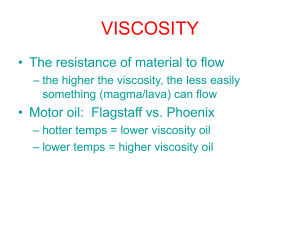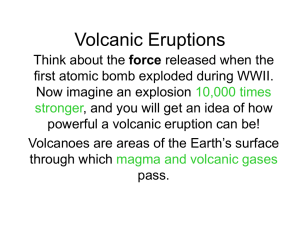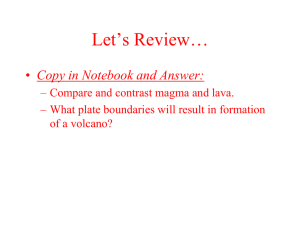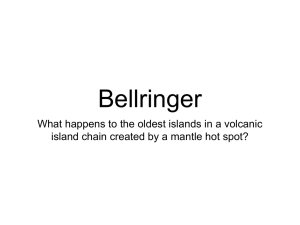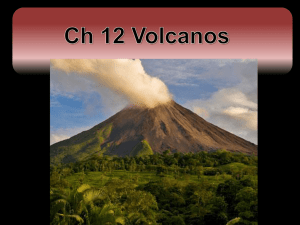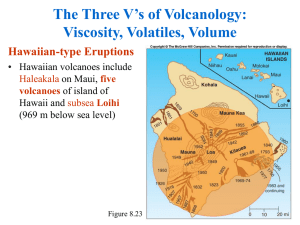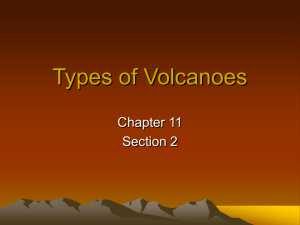Chapter 6
advertisement
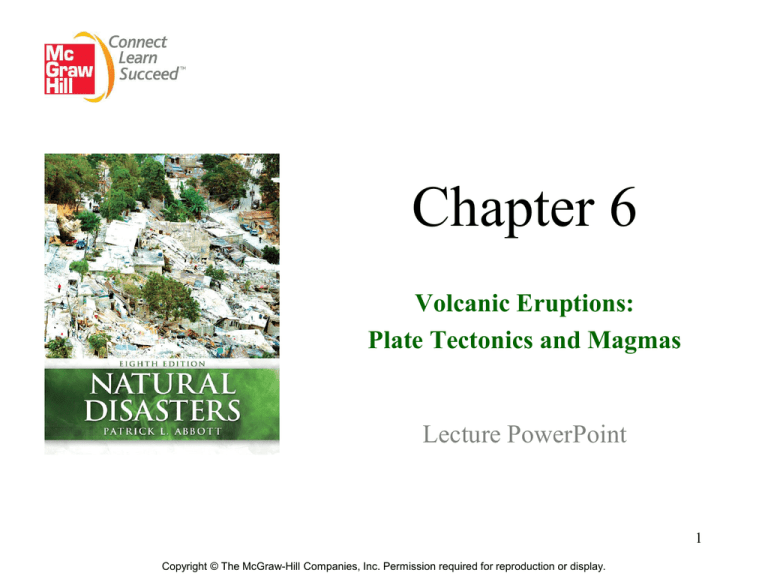
Chapter 6 Volcanic Eruptions: Plate Tectonics and Magmas Lecture PowerPoint 1 Copyright © The McGraw-Hill Companies, Inc. Permission required for reproduction or display. Vesuvius, 79 C.E. • Cities of Pompeii and Herculaneum buried by massive eruption which blew out about half of Mt. Vesuvius • Similar to 1991 eruption of Mt. Pinatubo in Philippines • Clouds of hot gas (850oC), ash and pumice enveloped city • Many tried to escape near sea, but were buried by pyroclastic flows Figure 6.1 Figure 6.3 Vesuvius, 79 C.E. • Vesuvius was inactive for 700 years before 79 CE eruption – People lost fear and moved in closer to volcano • After 79 CE, eruptions in 203, 472, 512, 685, 993, 1036, 1049, 1138-1139 • 500 years of quiet, then 1631 eruption killed 4,000 people • 18 cycles of activity between 1631 and 1944, nothing since then • 3 million people live within danger of Vesuvius today; 1 million people on slopes of volcano The Hazards of Studying Volcanoes • Eruptive phases are often separated by centuries of inactivity, luring people to live in vicinity (rich volcanic soil) – 400,000 people live on flanks of Galeras Volcano in Colombia • Many people killed each year by volcanoes, sometimes including volcanologists • Volcanoes may be active over millions of years, with centuries of inactivity How We Understand Volcanic Eruptions • Understand volcanoes in context of plate tectonics • Variations in magma’s chemical composition, ability to flow, gas content and volume determines whether eruptions are peaceful or explosive Plate-Tectonic Setting of Volcanoes • 90% of volcanism is associated with plate boundaries – 80% at spreading centers – About 10% at subduction zones • Remaining 10% of volcanism occurs above hot spots Figure 6.6 Plate-Tectonic Setting of Volcanoes • Subduction carries oceanic plate (with water-rich sediments) into hotter mantle, where water lowers melting temperature of rock • Rising magma melts continental crust it passes through, changing composition of magma Figure 6.7 Plate-Tectonic Setting of Volcanoes • No volcanism associated with transform faults or continentcontinent collisions • Oceanic volcanoes are peaceful • Subduction-zone volcanoes are explosive and dangerous – Subduction zones last tens of millions of years – Volcanoes may be active any time, with centuries of quiet Figure 6.7 Chemical Composition of Magmas • Of 92 naturally occurring elements: – Eight make up more than 98% of Earth’s crust – Twelve make up 99.23% of Earth’s crust – Oxygen and silicon are by far most abundant • Typically join up as SiO4 tetrahedron, that ties up with positively charge atoms to form minerals Figure 6.8 Chemical Composition of Magmas • Mineral formation in magma: crystallization • Order of crystallization of different minerals in magma can be determined: – Iron and magnesium link with aluminum and SiO4 to form olivine, pyroxene, amphibole and biotite families – Calcium combines with aluminum and SiO4 until calcium replaced by sodium, to form plagioclase feldspar family; calcium and sodium are later replaced by potassium, to form potassium feldspar and muscovite families; finally only Si and O remain, forming quartz Chemical Composition of Magmas Figure 6.9 Chemical Composition of Magmas • Elements combine to form minerals • Minerals combine to form rocks • Different compositions of magma result in different igneous rocks • If magma cools slowly and solidifies beneath surface plutonic rocks • If magma erupts and cools quickly at surface volcanic rocks Viscosity, Temperature, and Water Content of Magmas • Viscosity: internal resistance to flow – Lower viscosity more fluid behavior • Water, melted ice-cream – Higher viscosity thicker • Honey, toothpaste • Viscosity determined by: – Higher temperature lower viscosity – More silicon and oxygen tetrahedra higher viscosity – More mineral crystals higher viscosity • Magma contains dissolved gases: volatiles – Solubility increases as pressure increases and temperature decreases Viscosity, Temperature, and Water Content of Magmas • Consider three types of magma: basaltic, andesitic and rhyolitic – Basaltic magma has highest temperatures and lowest SiO2 content, so lowest viscosity (fluid flow) – Rhyolitic has lowest temperatures and highest SiO2 content, so highest viscosity (does not flow) – Basaltic makes up 80% of magma that reaches Earth’s surface, at spreading centers, because it forms from melting of mantle – Melted mantle at subduction zones rises through continental crust before reaching the surface, incorporating continental high SiO2 rock as it rises, to become andesitic or rhyolitic in composition before it erupts Viscosity, Temperature, and Water Content of Magmas Insert Table 6.5 Viscosity, Temperature, and Water Content of Magmas • Water is most abundant dissolved gas in magmas • As magma rises, pressure decreases, water becomes steam bubbles – Basaltic magma has lower water content peaceful, safe eruptions – Rhyolitic magma has higher water content and high viscosity many steam bubbles form and can not escape through thick magma, so explode out violent, dangerous eruptions Figure 6.11 Figure 6.12 Plate-Tectonic Setting of Volcanoes Revisited • Spreading centers have abundant volcanism because: – Sit above hot asthenosphere – Asthenosphere has low SiO2 – Plates pull apart so asthenosphere rises and melts under low pressure, changing to high-temperature, low SiO2, low volatile, low viscosity basaltic magma that allows easy escape of gases peaceful eruptions Plate-Tectonic Setting of Volcanoes Revisited • Subduction zones have violent eruptions because: – Magma is generated by partial melting of the subducting plate with water in it – Melts overlying crust to produce magmas of variable composition – Magma temperature decreases while SiO2, water content and viscosity increase violent eruptions Figure 6.13 How a Volcano Erupts • Begins with heat at depth – Rock that is superheated (heated to above its melting temperature) will rise – As it rises, it is under less and less pressure so some of it melts (becomes magma) – Volume expansion leads eventually to eruption • Three things will cause rock to melt: – Lowering pressure – Raising temperature – Increasing water content • Lowering pressure is most common way to melt rock decompression melting How a Volcano Erupts • Magma at depth is under too much pressure for gas bubbles to form (gases stay dissolved in magma) Figure 6.14 • As magma rises toward surface, pressure decreases and gas bubbles form and expand, propelling the magma farther up • Eventually gas bubble volume may overwhelm magma, fragmenting it into pieces that explode out as a gas jet How a Volcano Erupts Eruption Styles and the Role of Water Content • Concentration of water in magma largely determines peaceful or explosive eruption • Basaltic magma can erupt violently with enough water • Rhyolitic magma usually erupts violently because of high water content, high viscosity (secondary role) • Styles of volcanic eruptions Figure 6.16 – Nonexplosive Icelandic and Hawaiian – Somewhat explosive Strombolian – Explosive Vulcanian and Plinian How a Volcano Erupts Some Volcanic Materials • Low-water content, low-viscosity magma lava flows • High-water content, high-viscosity magma pyroclastic debris Insert Table 6.6 How a Volcano Erupts Nonexplosive eruptions • Pahoehoe: smooth ropy rock from highly liquid lava • Aa: rough blocky rock from more viscous lava Figure 6.17 Figure 6.18 How a Volcano Erupts Explosive eruptions • Pyroclastic debris: broken up fragments of magma and rock from violent gaseous explosions, classified by size • May be deposited as: – Air-fall layers (settled from ash cloud) – High-speed, gas-charged pyroclastic flow Figure 6.19a Figure 6.20 How a Volcano Erupts Explosive eruptions • Very quick cooling: – Obsidian: volcanic glass forms when magma cools very fast – Pumice: porous rock from cooled froth of magma and bubbles Figure 6.21 Side Note: How a Geyser Erupts • Geyser: eruption of water superheated by magma • Can only exist in areas of high heat flow underground • Water boils (becomes gas) at 100oC unless it is under pressure – no room for expansion to gas state – Water can be heated to higher than boiling temperature superheated – When superheated water reaches point of lower pressure, it flashes to steam violently, and erupts out of the ground Figure 6.22 The Three V’s of Volcanology: Viscosity, Volatiles, Volume • Viscosity may be low or high – Controls whether magma flows easily or piles up • Volatile abundance may be low, medium or high – May ooze out harmlessly or explode • Volume may be small, medium or large – Greater volume more intense eruption The Three V’s of Volcanology: Viscosity, Volatiles, Volume • By mixing different values for the three V’s, can forecast different eruptive styles for volcanoes Insert Table 6.7 The Three V’s of Volcanology: Viscosity, Volatiles, Volume • By mixing different values for the three V’s, can define different volcanic landforms Insert Table 6.8 The Three V’s of Volcanology: Viscosity, Volatiles, Volume Shield Volcanoes: Low Viscosity, Low Volatiles, Large Volume • Basaltic lava with low viscosity and low volatiles flows to form gently dipping, thin layers • Thousands of layers on top of each other form very broad, gently sloping volcano like Mauna Loa in Hawaii • Great width compared to height Figure 6.24 The Three V’s of Volcanology: Viscosity, Volatiles, Volume Hawaiian-type Eruptions • “Curtain of fire”: lines of lava fountains up to 300 m high • Low cone with high fountains of magma – Floods of lava spill out and flow in rivers down slope – Eruptions last days or years, usually not life-threatening but destroy buildings and roads Figure 6.26 The Three V’s of Volcanology: Viscosity, Volatiles, Volume Hawaiian-type Eruptions Hawaiian volcanoes include Haleakala on Maui, five volcanoes of island of Hawaii and subsea Loihi (969 m below sea level) Figure 6.25 The Three V’s of Volcanology: Viscosity, Volatiles, Volume Killer Event of 1790 Rare Hawaiian killer pyroclastic events – King Keoua’s army passing through Kilauea area was stopped by eruptions and split into three groups to escape area – Base surge overtook middle group, killing all 80 Explosion column burst upward as dense basal cloud swept downhill Cloud of hot water and gases sometimes with magma fragments The Three V’s of Volcanology: Viscosity, Volatiles, Volume Icelandic-type Eruptions Most peaceful type of eruption Fissure eruptions: – Lava pours out of linear vents or long fractures up to 25 km long – “Curtain of fire” effect Low-viscosity, low-volatile lava flows almost like water Build up volcanic plateaus (even flatter than shield volcanoes) of nearly horizontal basalt layers In Greater Depth: Volcanic Explosivity Index Provides a means of evaluating eruptions according to volume of material erupted, height of eruption column and duration of major eruptive blast scale from 0 to 8 Insert Table 6.9 The Three V’s of Volcanology: Viscosity, Volatiles, Volume Flood Basalts: Low Viscosity, Low Volatiles, Very Large Volume Largest volcanic events known on Earth Immense amounts of basalt erupted Geologically short time (1 to 3 million years) – Different from hot spots that last hundreds of millions of years Can have global effects as huge amounts of gases (including CO2 and SO2) are released into atmosphere Some flood basalts coincide with mass extinctions: – Siberia (250 million years ago): 3 million km3 of basalt – India (65 million years ago): 1.5 million km3 of basalt The Three V’s of Volcanology: Viscosity, Volatiles, Volume Scoria Cones: Medium Viscosity, Medium Volatiles, Small Volume Low conical hills (also known as cinder cones) of basaltic to andesitic pyroclastic debris built up at volcanic vent Can have summit crater with lava lake during eruption Form during single eruption lasting hours to several years Figure 6.27 The Three V’s of Volcanology: Viscosity, Volatiles, Volume Strombolian-type Eruptions Scoria cones usually built by Strombolian eruptions Named for Stromboli volcano in Italy, erupting almost daily for millennia (tourist attraction) – Central lava lake with thin crust that breaks easily to allow occasional frequent eruptive blasts of lava and pyroclastic debris Michoacan, Mexico – New scoria cone born in farm field and built up by nine years of eruptions, burying area and destroying two towns The Three V’s of Volcanology: Viscosity, Volatiles, Volume Stratovolcanoes: High Viscosity, High Volatiles, Large Volume Steep-sided, symmetrical volcanic peaks Composed of alternating layers of pyroclastic debris and andesitic to rhyolitic lava flows Eruptive styles from Vulcanian to Plinian Figure 6.28 The Three V’s of Volcanology: Viscosity, Volatiles, Volume Vulcanian-type Eruptions Alternate between highly viscous lava flows and pyroclastic eruptions Common in early phase of eruptive sequence before larger eruptions (‘clearing throat’) The Three V’s of Volcanology: Viscosity, Volatiles, Volume Plinian-type Eruptions Named for Pliny the Younger (descriptions of 79 C.E. eruption of Mt. Vesuvius) Occur after ‘throat is clear’, commonly final eruptive phase Gas-powered vertical columns of pyroclastic debris up to 50 km into the atmosphere The Three V’s of Volcanology: Viscosity, Volatiles, Volume Vesuvius, 79 CE Caused by subduction of Mediterranean seafloor beneath Europe, by northward movement of Africa Most of 4,000 people who remained in Pompeii killed by thick layers of hot pumice or pyroclastic flows from Vulcanian-type eruption, followed by Plinian-type eruption Seismic waves define 400 km2 magma body 8 km under Vesuvius today Millions of people live around Bay of Naples area The Three V’s of Volcanology: Viscosity, Volatiles, Volume Vesuvius, 79 CE Figure 6.29 The Three V’s of Volcanology: Viscosity, Volatiles, Volume Vesuvius, 79 CE Plinian-type eruptions can create ‘volcano weather’, when steam in eruption column cools and condenses to fall as rain, mixing with ash on volcano’s slopes and creating mudflows (lahars) that can be devastating Lahars buried Herculaneum Figure 6.30 Side Note: British Airways Flight 9 1982 flight from Kuala Lumpur, Malaysia to Perth, Australia lost all four engines at 37,000 feet Plane descended to 12,000 feet before engines started again Emergency landing in Jakarta Plane had flown through eruption cloud of hot volcanic ash and pyroclastic debris from Mount Galunggung The Three V’s of Volcanology: Viscosity, Volatiles, Volume Lava Domes: High Viscosity, Low Volatiles, Small Volume Form when high-viscosity magma at vent of volcano cools quickly into hardened plug – Gases accumulated at top of magma chamber power Vulcanian and Plinian blasts until most volatiles have escaped – Remaining magma is lowvolatile, high-viscosity paste – Oozes to vent and cools quickly in place, forming plug Figure 6.32 The Three V’s of Volcanology: Viscosity, Volatiles, Volume A Typical Eruption Sequence Gas-rich materials shoot out first as Vulcanian blast, followed by longer Plinian eruption After gas depleted, high-viscosity magma builds lava dome over long period Vulcanian precursor Plinian main event lava dome conclusion The Three V’s of Volcanology: Viscosity, Volatiles, Volume Calderas: High Viscosity, High Volatiles, Very Large Volume Calderas: large volcanic depressions (larger than crater) formed by inward roof collapse into partially emptied magma reservoirs Form at different settings: – Summit of shield volcanoes, such as Mauna Loa or Kilauea – Summit of stratovolcanoes, such as Crater Lake or Krakatau – Giant continental caldera, such as Yellowstone or Long Valley Ultraplinian eruptions at Toba on Sumatra (74,000 years ago) formed 30 x 100 km caldera with central raised area – resurgent caldera The Three V’s of Volcanology: Viscosity, Volatiles, Volume Calderas: High Viscosity, High Volatiles, Very Large Volume Figure 6.34 Figure 6.33 The Three V’s of Volcanology: Viscosity, Volatiles, Volume Crater Lake (Mount Mazama), Oregon Formed about 7,600 years ago from stratovolcano Mt. Mazama Major eruptive sequence of pyroclastic flows and Plinian columns emitted ash layer recognizable across North America Large enough volume of magma erupted to leave void beneath surface mountain collapsed into void leaving caldera crater at surface that filled with water to form Crater Lake 1,000 year old successor volcanic cone Wizard Island Figure 6.35 The Three V’s of Volcanology: Viscosity, Volatiles, Volume Crater Lake (Mount Mazama), Oregon Figure 6.36 The Three V’s of Volcanology: Viscosity, Volatiles, Volume Krakatau, Indonesia, 1883 Part of volcanic arc above subduction zone between Sumatra and Java After earlier collapse, Krakatau built up during 17th c. – Quiet for two centuries then resumed activity in 1883 – Moderate Vulcanian eruptions from dozen vents – Led up to enormous Plinian blasts and eruptions 80 km high and audible 5,000 km away – Blew out 450 m high islands into 275 m deep hole – Triggered tsunami 35 m high killing 36,000 people Has been building new cone Anak Krakatau since 1927 The Three V’s of Volcanology: Viscosity, Volatiles, Volume Santorini and the Lost Continent of Atlantis Figure 6.37 Mediterranean plate subducting beneath Europe many volcanoes including stratovolcano Santorini Series of eruptions around 1628 B.C.E.: – 6 m thick layer of air-settled pumice – Several meter thick ash deposits from when seawater reached magma chamber steam blasts – 56 m thick ash, pumice, rock fragments from collapse of cones – Layers of ash and rock fragments from magma body degassing The Three V’s of Volcanology: Viscosity, Volatiles, Volume Santorini and the Lost Continent of Atlantis Effects on local Minoan culture: – Akrotiri had three-story houses, sewers, ceramics and jewelry, trade with surrounding cultures – Destruction of part of Minoan civilization made great impact story of disappearance of island empire of Atlantis made be rooted in this event Figure 6.38 In Greater Depth: Hot Spots Shallow hot rock masses/magmas or plumes of slowly rising mantle rock operating for about 100 million years Used as reference points for plate movement because almost stationary, while plates move above them 122 active in last 10 million years, largest number under Africa (stationary plate concentrates mantle heat) Oceanic hot spots: – Peaceful eruptions build shield volcanoes (Hawaii) Spreading center hot spots: – Much greater volume of basaltic magma, peaceful (Iceland) Continental hot spots: – Incredibly explosive eruptions as rising magma absorbs continental rock, form calderas (Yellowstone) In Greater Depth: Hot Spots Figure 6.39 The Three V’s of Volcanology: Viscosity, Volatiles, Volume Three calderas in U.S. known to have erupted in last million years: – Valles caldera in New Mexico, about 1 million years ago, in Rio Grande rift – Long Valley, California, about 760,000 years ago, edge of Basin and Range – Yellowstone, Wyoming, about 600,000 years ago, above a hot spot Occur where large volumes of basaltic magma intrude to shallow depths and melt surrounding continental rock, to form high-viscosity, high-volatiles magma The Three V’s of Volcanology: Viscosity, Volatiles, Volume Yellowstone National Park Resurgent caldera above hot spot below North America, body of rhyolitic magma 5 to 10 km deep North American plate movement (southwestward 2-4 cm/yr) is recorded by trail of volcanism to the southwest Figure 6.40 The Three V’s of Volcanology: Viscosity, Volatiles, Volume Yellowstone National Park Three recent catastrophic (ultra-Plinian) eruptions: – 2 million years ago, 2,500 km3 – 1.3 million years ago, 280 km3 – 0.6 million years ago, 1,000 km3, created caldera 75 km by 45 km, covering surrounding 30,000 km2 with ash Figure 6.41 The Three V’s of Volcanology: Viscosity, Volatiles, Volume Eruptive Sequence of a Resurgent Caldera Very large volume of rhyolitic magma bows ground upward Accumulates cap rich in volatiles and low-density material Circular fractures form around edges Plinian eruptions, then pyroclastic flows as more magma is released than can vent upwards Figure 6.42 The Three V’s of Volcanology: Viscosity, Volatiles, Volume Eruptive Sequence of a Resurgent Caldera As magma body shrinks, land surface sinks into void New mass of magma creates resurgent dome next eruption Figure 6.42 End of Chapter 6
